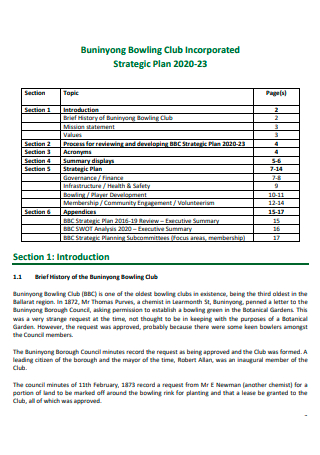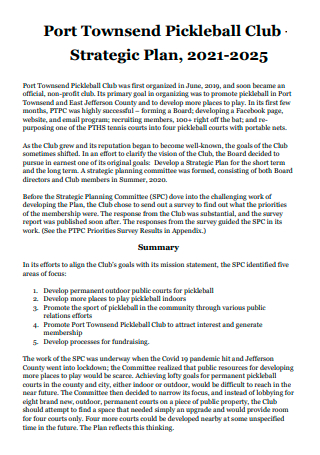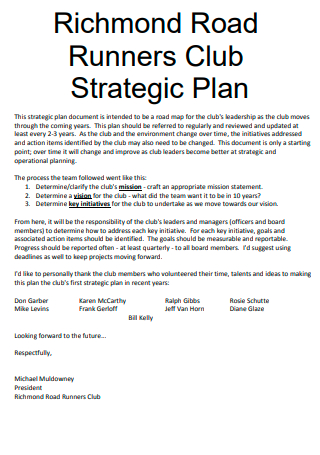34+ Sample Club Strategic Plan
-

Club Strategic Plan Template
download now -

Cricket Club Strategic Plan
download now -

Private Club and Board Expectations Strategic Planning
download now -

Club Survival and Success Strategic Planning
download now -

Club Five Year Strategic Plan
download now -

Draft Club Strategic Plan
download now -

Sporting Club Incorporated Strategic Plan
download now -

District Flying Club Strategic Plan
download now -

Bowling Club Incorporated Strategic Plan
download now -

Standard Club Strategic Plan
download now -

General Federation of Women Club Strategic Plan
download now -

Garden Club Strategic Planning Project
download now -

Private Club Strategic Planning
download now -

Club Strategic Plan Example
download now -

Visionary Goals Club Strategic Plan
download now -

Ball Club Strategic Plan
download now -

Boys and Girls Club Strategic Plan
download now -

Club Strategic Plan in PDF
download now -

Road Runners Club Strategic Plan
download now -

Athletics Club Strategic Plan
download now -

Simple Club Strategic Plan
download now -

Sample Club Strategic Plan
download now -

Club Home Owners Association Strategic Plan
download now -

Boat Club Strategic Plan
download now -

Rotary Club Strategic Plan
download now -

Old Club Strategic Plan
download now -

Rowing Club Strategic Plan
download now -

Printable Club Strategic Plan
download now -

Basic Club Strategic Plan
download now -

Sailing Club Strategic Plan
download now -

Formal Club Strategic Plan
download now -

Swimming Club Strategic Plan
download now -

Club Strategic Plan Format
download now -

Lawn Tennis Club Strategic Plan
download now -

Island Club Strategic Plan
download now
FREE Club Strategic Plan s to Download
34+ Sample Club Strategic Plan
a Club Plan?
Benefits of Joining a Club
Mistakes To Avoid When Choosing Clubs
How Should Strategic Planning Be Approached
FAQs
Why is it critical for a club to have an action plan?
What factors contribute to the success of a club?
What is the club’s purpose?
What Is a Club Plan?
A club plan outlines the club’s future objectives. It defines the club’s goals, how they will be accomplished, and when they will be conducted. It should be an easy-to-read document; therefore, the first recommendation is to keep it brief, straightforward, and transparent. Financial instability is the greatest threat to any club’s survival in today’s weak economy and club climate. Numerous reasons and conditions can contribute to this syndrome, especially in towns where a single firm or industry dominates the landscape. Though change is never required and survival is not needed, strategic planning can help a club improve its thinking and operations for a better chance of success. Bear in mind that numerous risks can damage a club in some ways, some of which are unavoidable and unavoidable, while others are self-inflicted. If a club desires to continue to exist in the next decade or so, a strategic plan can assist in achieving this goal. According to studies of high school students, approximately 25% of teenagers join musical clubs, such as choir or band, and 20% join intellectual or vocational organizations, such as a science club or a Spanish club.
Benefits of Joining a Club
Joining a club allows you to participate in new and enjoyable events, take a vacation from studying, and maximize your university experience. The experience may inspire you to pursue a new pastime, contribute to a cause near and dear to your heart, connect with others who share the same interest, and have fun! Also, here are a few of its additional advantages:
Mistakes To Avoid When Choosing Clubs
Joining student groups can be an excellent way to enhance your student experience. Numerous institutions feature some student organizations devoted to a variety of interests. Whether you’re like sports, cooking, social concerns, or even K-pop, there’s almost certainly something for you here! However, it cannot be easy to select amongst them with many choices. Here are some frequent errors to avoid.
1. Enrolling in any intriguing club
When I first started university, I recall attending a clubs expo to learn about various student organizations on campus. All around me were colorful poster-covered stalls, tables filled in fliers and booklets, and excited students eager to discuss the benefits of joining their organization. I had probably signed up for maybe 10-15 clubs by the time I left. I even joined up for one on coding,o an area in which I had previously been uninterested. Over the next week, my email inbox became clogged with messages from all the mailing lists I had subscribed to, and I began to grasp the magnitude of the strain on my courses. I did not join each of those clubs. If you’re a curious individual eager to participate, that’s fantastic! I would strongly advise you to join student organizations. However, rather than joining up for every single one that piques your interest, focus on a few ones you’re genuinely passionate about being a part of. Conduct preliminary research and select clubs to which you are likely to commit.
2. Failing to comprehend what you’re getting yourself into
It’s critical to have a fundamental comprehension of the situation you’re about to enter. Certain clubs do not demand any commitment on your part. Rather than that, you can attend their events whenever you choose and, if you become too busy or bored, no issue! Other clubs may expect you, mainly if you take on a leadership or organizing position. If this is the issue, make an effort to ascertain the time commitment in advance. Some clubs hold regular meetings that may conflict with your other obligations. When I was investigating two comparable clubs, I found out that one of them met regularly during my work hours, so I would have been unable to attend their events.
3. You believe you lack the necessary abilities or expertise
While it is essential to conduct preliminary research, avoid rejecting clubs because you think you will not be good enough. One of the most acceptable reasons to join a club is to experience something new. You can enhance your abilities and acquire experience. Who knows, you might even create a unique interest! On the other hand, you may try something and discover it isn’t your cup of tea. That is also acceptable. If you’re interested in attempting a new sport or pastime, go for it! Numerous clubs are welcoming to newcomers and cater to beginners. You’ll have an opportunity to acquire the knowledge you require, and it may not be as difficult as you initially expected.
4. Refusing to join a club due to a lack of familiarity
We are all aware that it might be unsettling to find ourselves in a position where we do not know anyone. However, it is sometimes required. If you’re only contemplating student clubs where you know at least one other person, or if you’re only willing to attend with one of your pals, you’re limiting your options. Joining a club is an excellent way to connect with like-minded individuals and form new friendships. Indeed, not knowing anyone might be advantageous because it forces you to communicate with strangers.
5. Join clubs that you believe will enhance your CV.
It’s a well-known fact that prospective employers will be curious about your extracurricular activities. Your participation in clubs can help you project an image of a well-rounded individual and provide insight into your interests. With this in mind, joining clubs that sound remarkable may appear attractive. After all, who wouldn’t want to put “President of the business consultancy club” on their resume? However, remember that there are multiple advantages to joining a club, and you should not let this be the determining factor. Also, if you mention your membership with a club on your resume, you will be asked what you contributed and what you learned. This could make you uncomfortable if you were not an active participant. Finally, there is no reason to complicate the procedure of joining clubs. While there are some typical pitfalls to avoid, if you have done your research and are genuinely interested in the subject matter of a group, feel free to join!
How Should Strategic Planning Be Approached
A strategic plan considers all of the possible outcomes for your firm and then narrows it down to the ones that are indeed feasible. Certain firms develop strategic plans with five-year, three-year, or even shorter time horizons in mind, mainly if they compete in a fast-moving market. Additionally, you can view sample health and safety strategy plans. Strategic planning enables managers to prioritize which elements of the organization warrant their time, people capital, and financial resources. When considering the scale of a strategic plan, it may appear to be an impossible undertaking to complete. However, splitting it into smaller, more manageable components may become much more doable. You may also be interested in examples of maintenance strategy plans. Perhaps our five-step strategy will assist you in effectively completing the strategic planning process:
-
Step 1 Know where you are.
While this may appear to be an easy task, it is considerably more complicated than it seems. Many people view themselves in the manner they wish to be seen, which further complicates the process because one’s viewpoint can differ significantly from another’s. Additionally, you can view samples of Strategic Audit Plans. Conduct a series of internal and external audits to gain a clear and exact picture of your firm’s marketplace, competitive environment, and genuine competencies.
-
Step 2 Determine what is critical.
Always keep the overall picture in mind. This will assist you in determining the long-term direction of your firm. Having a clear path will guide you toward the organization’s goal and mission. This detailed study will assist you in identifying the critical issues that require the management team’s immediate attention. By prioritizing and addressing these concerns, you can avoid them escalating and negatively impacting the organization’s Business Operations.
-
Step 3 Define your goals.
Ambiguous goals will get you nowhere. Declaring, “For the organization to become the finest in the business in the next ten years,” is not only audacious but also too ambiguous for your people to comprehend. This will only serve to confuse and disappoint. Rather than that, set your objectives in a way that makes it crystal apparent what your business must accomplish to address the critical concerns. This must also be consistent with your organization’s general Mission and Vision Statements.
-
Step 4 Determine who is responsible.
Each member of an organization is critical to its continued survival. This is why the organization’s success must appoint a set of skilled personnel to manage the various components and duties of the business. The strategies, Action Plans, and budgets are critical components of the process because they effectively explain how time, people, and money should be allocated to address priority issues and achieve the intended outcomes.
-
Step 5 Review
Even if a recommended plan has been adopted, your concerns are merely beginning. To guarantee that your strategic plan functions as planned, you must set aside time regularly to undertake formal assessments of the process. You may be interested in samples of communication strategy plans. Remember that your goal should always be adaptable, as unforeseen occurrences may require you to make abrupt modifications throughout the process. It is critical to revise your general plan at least once per quarter to ensure that it remains relevant and successful to achieve more remarkable results and keep your organization on track. Having a strategic strategy for your group can work wonders. It can transport you to places you never imagined were conceivable. Simple techniques will inevitably alter over time as the organization matures as a whole.
FAQs
Why is it critical for a club to have an action plan?
All plans must include specific activities to attain agreed-upon results over a particular time. Your club’s plans are critical tools that can help ensure your club’s longevity, financial stability, innovation, and overall success.
What factors contribute to the success of a club?
Members have the opportunity to engage in significant community service. Members of the club have the chance to select and learn about community issues that are important to them. Members acquire leadership skills through their involvement in the group. Members become involved in club activities and beyond.
What is the club’s purpose?
A club is many people who share a common interest or objective. For instance, a service club exists to engage in volunteer or charitable exercises. There are clubs dedicated to hobbies and sports, groups devoted to social activities, and politics and religion.
If you want to comprehend more about developing a club strategic plan, you must browse our website. It has a variety of articles that might supply you with the information you’re looking for. All that is required of you is a thorough reading of these articles.
